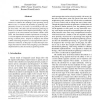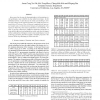89 search results - page 7 / 18 » Moore's Law is Unconstitutional |
RECONFIG
2008
IEEE
14 years 2 months ago
2008
IEEE
In the context of the emergence of alternative computing resources to address the challenge of the upcoming end of Moore’s law, we consider the feasibility of gathering computat...
FDL
2005
IEEE
14 years 1 months ago
2005
IEEE
Although Moore’s Law enables a huge number of components to be integrated into a single chip, design methods that will allow system architects to put the components together to ...
ISVLSI
2003
IEEE
14 years 1 months ago
2003
IEEE
The need for small, high speed, low power computers as the end of Moore’s law approaches is driving research into nanotechnology. These novel devices have significantly differe...
COCOON
2000
Springer
14 years 4 days ago
2000
Springer
The integer factorisation and discrete logarithm problems are of practical importance because of the widespread use of public key cryptosystems whose security depends on the presum...
ICCAD
1997
IEEE
14 years 17 hour ago
1997
IEEE
Interconnect has become the dominating factor in determining circuit performance and reliability in deep submicron designs. In this embedded tutorial, we first discuss the trends...


